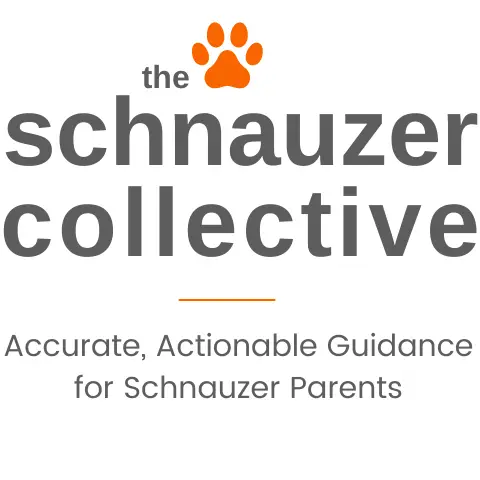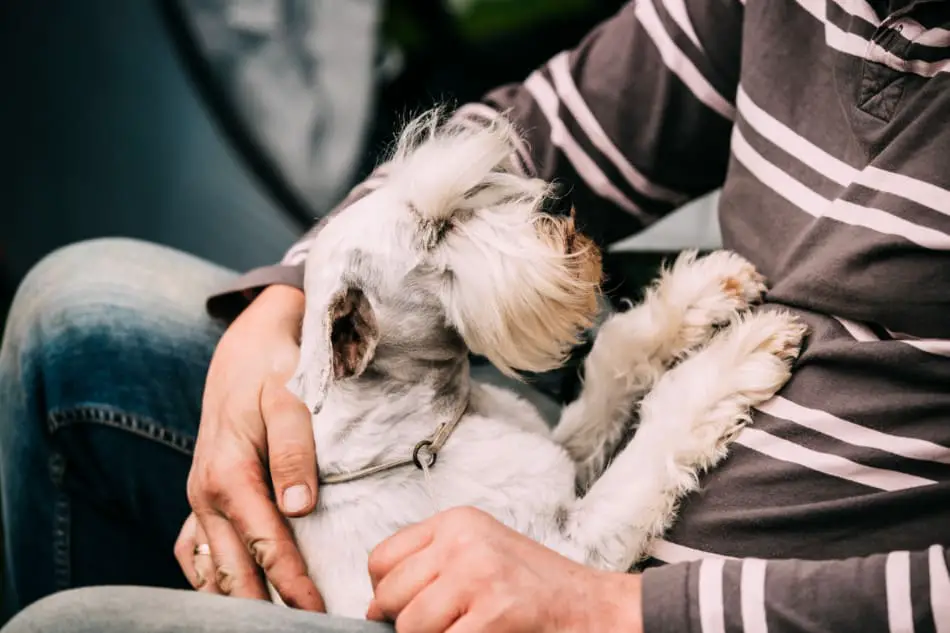When we brought Livi home from her breeder, our new family of six took time to settle in and get to know each other. It didn’t take long. Because Livi was such a fun and loving addition to our family, we started to consider how we could share her with people around us who might need support. I began to research ways that Schnauzers can be of service to a community, and here is what I found:
Can Schnauzers Be Good Therapy or Service Dogs? Yes! Schnauzers have therapeutic effects on the physical and psychological conditions people might experience. They are loving and intelligent, and can be trained as either therapy or service dogs.
As therapy dogs, Schnauzers bring comfort and affection to people in health institutions, schools, retirement homes, among other places. As service dogs, Schnauzers can help physically challenged people to live a more independent and freedom-filled life.
Each Schnauzer breed is best-suited for training as either a service or therapy dog. Miniature Schnauzers are small, non-threatening, and their size alone makes them perfect as a therapy dog. Standard and Giant Schnauzers are well-suited as service dogs due to the size, strength, and the fact that they have a history of being trained as guard dogs and police dogs. All three breeds are easy to train, and they can all be of service in meaningful ways to people around you.
Let’s dive into how Schnauzers can benefit communities by lending service.
Miniature Schnauzers as Therapy Dogs
Schnauzers were bred to participate in a family and take on responsibilities. They thrive around the people they love and can learn to lovingly accept strangers.
It is a well-documented fact that dogs can have a calming effect on our emotions and even our physical health. Dogs can lift spirits and contribute to an overall sense of well-being. Schnauzers, in particular, are well-suited for being socialized and trained to serve as therapy dogs.

The following are a few characteristics needed for this breed to become therapy dogs:
- They should be friendly. Schnauzers should accept strangers without any problem. Everybody can handle them, including kids and little children.
- They should get along with other animals. This is a requirement because a therapy dog works in hospitals, schools, retirement homes, plus in other places where they are needed. In most cases, other therapy animals also visit these places.
- They should have good temperament. Therapy dogs should be calm and gentle. For instance, in a mental hospital, the dog might be provoked by the patients. If the animal is high-tempered, it might attack the patients instantly.
- They should be a manageable size. Miniature schnauzers are the smallest breed compared to Standard and Giant schnauzers. For this reason, they can be petted, hugged, and carried easily by the people that they are trained to help.
Training and Certification for Therapy Dogs
While many adult Schnauzers can still be trained as a therapy dog, training generally starts while the dog is very young, around two months old. Start with basic puppy training and continue with additional intermediate and advanced obedience trainings.
Puppy and adult dog training programs will give you the confidence that your Schnauzer is well-socialized, obedient, and prepared for a variety of social situations.
In addition to knowing basic signals and behaviors, you will know how well she can tolerate and handle normal distractions in any therapy environment such as other animals, people, sounds, smells, unfamiliar objects and surroundings.
Ultimately, the more training your Schnauzer has and the more often you can get her out into new environments and situations, the more prepared she will be for work as a therapy dog.
It is also wise to specifically include a training class that will lead to an American Kennel Club Canine Good Citizen (AKC CGC) certificate. In America, this is nationally recognized as the highest standard of dog behavior and will prepare you for the final step of therapy dog training.
While the AKC does not offer a therapy dog training program, they do honor the official training work offered by organizations around the country and will award an AKC Therapy Dog title when your Schnauzers is certified by one of the groups. You can find national training organizations as well as a thorough list of therapy groups on the AKC website.
As a final training capstone, you will need work with one of these organizations to earn a pet therapy certification. The options can vary from an online application and proof of training, or a full in-person observation.
An in-person observation will generally include at least the following:
- If she listens to and obeys you
- How she reacts around other animals
- If she lets strangers touch, pet, and handle her
- Whether or not she jumps on people
- If she walks on a leash without pulling
- If she tolerates strange noises, smells, and objects
- How she reacts to sick people, unsteady walking, and medical environments
All therapy dogs must be current on all vaccines required by the local laws and will need to pass a fecal test every 12 months. Of course, your therapy Schnauzer should always be freshly groomed, clean, and very healthy.
Once you are ready to take your Schnauzer out as a therapy dog, contact organizations you are interested in and fully understand what, if any, additional requests or requirements they have. As a human volunteer, you should also absolutely consider liability insurance.
Schnauzers can be trained for the specific skills they need as therapy and service dogs, and they can learn to benefit a wider community.
THE SCHNAUZER COLLECTIVE
Standard and Giant Schnauzers as Service Dogs
Service dogs are quite helpful to people living with disabilities. These dogs help create a sense of independence, freedom, and companionship to the disabled person. Standard and Giant Schnauzers are perfect for this role.

Some of the characteristics required for service dogs include:
- They should be physically strong. Service dogs are regarded as working dogs and not pets. Therefore, they need to be physically fit and strong to perform their duties well.
- They should be easily trainable. Training a service dog to handle various tasks is not a simple job. However, Standard and Giant Schnauzers are quick to grasp and internalize training. They are eager to be of service and learn new skills.
- They should have a good temperament. Just like therapy dogs, Schnauzers trained to be service dogs should be naturally calm and gentle. They should not be easily provoked.
- They should be healthy. Healthy dogs tend to serve their handlers better and are free from their own physical challenges.
Training and Certification for Service Dogs
Just like therapy dogs, training service dogs starts early in their lives. For a person to qualify and own a service dog, they must be living with a disability that prevents them from performing an essential task in life. The training that the dog gets is in line with the activity the disabled person is unable to do.
There are two options for training a service dog: owner training and professional training.
Owner Training
And individual with disabilities has the right to train their own service dog. Standard and Giant Schnauzers can be excellent service companions, and when properly trained, can perform many helpful tasks.
Like all service dogs, Schnauzers being considered for owner-led training as a service dog should:
- Be able to stay calm, especially in unfamiliar settings
- Be alert to the environment, but not reactive to his surroundings
- Be trainable and willing to become comfortable with many different situations and environments
- Be willing to please and help their training and owner
- Be able to learn and retain information
- Be extremely consistent and reliable in performing repetitive tasks
Owner-led training should include basic socialization, commands, and full obedience training. The Schnauzer should then be taught the specific tasks necessary to help and support his disabled owner.
If a Schnauzer is being owner-trained to support a veteran, there are stricter standards for qualification and certification. Take a look at “Final Service Dog Approval Tests” below.
Professional Training
A service dog generally commits to between 18 months and two years of very specialized task training that teaches them the specific skills needed to assist people with physical disabilities.
A trained service dog can then be paired with his disabled owner and together they will embark on additional training. The additional training ensures that they are a good match for the long term.
Professional service dog training programs have very high standards for the dogs they accept, and they also have a very high dropout rate. The quality and level of training can be excellent, but be aware that some professional service dog training programs can cost upwards of $25,000. Be sure to do thorough research before purchasing training.
Final Service Dog Approval Tests
As with therapy dogs, all owners and trainers of service dogs should work with the American Kennel Club to qualify for their Good Canine Citizen recognition. This is considered to be the gold standard for all dog behavior and serves as one highly respected gateway to acknowledgment of an official service dog.
For service to veterans, there are now additional requirements for qualifying as a service dog. The Schnauzer would need to pass GCC Plus, which includes the AKC’s Canine Good Citizen, Community Canine, and Urban CGC tests. The Schnauzer would also need to demonstrate proficiency in assisting a disabled person with three randomly selected services.
The AKC has provided a comprehensive look at their support of service and therapy dogs, the American Disability Act requirements for service dogs, and links to available training and testing options.
Your Schnauzer Can Help Others
Dogs are “man’s best friend” for many reasons, much of which have to do with their potential for loving, meaningful interaction with us. They can be solid companions through the ups and downs of life and contribute to our well-being.
In addition, Schnauzers can be trained for the specific skills they need as therapy and service dogs, and they can learn to benefit a wider community.
Lucky us!
And finally, from one pet parent to another, discover my all-time favorite resources designed to cover your every Schnauzer need. I’ve done the legwork for you so you can spend more time with the people and fur friends in your life.
A portion of all profit earned on this site is donated to Pet Partners
whose mission is to improve human health and
well-being through the human-animal bond.
They train and register pets to become therapy animals,
and have local chapters in many states.

